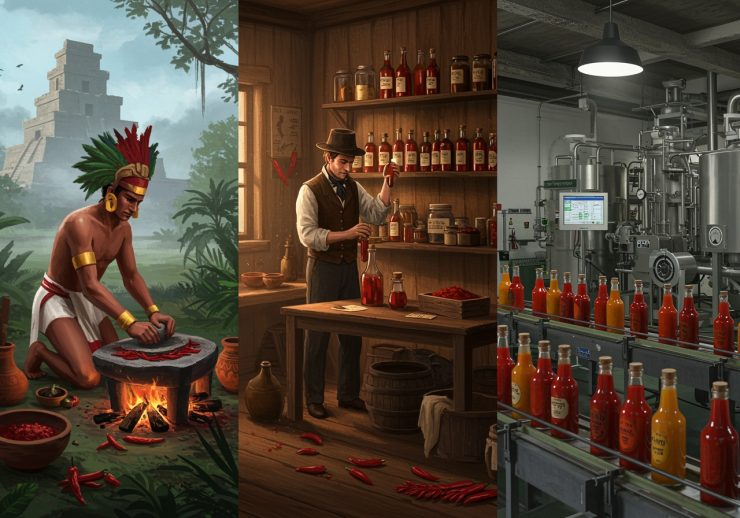The history of hot sauce isn’t just about adding heat—it’s a global story of trade, tradition, and taste. Hot sauce traces back thousands of years from Aztec chilli water to modern-day Sriracha and ghost pepper madness. It’s crossed continents, cultures, and Scoville scales to become one of the most beloved condiments in the world. Whether you prefer smoky, tangy, or tear-inducing, the story behind the sauce is just as spicy as the sauce itself.
Ancient Origins (7000 BCE – 15th Century)
Before Tabasco was bottled and anyone uttered the words “Sriracha sauce”, chili peppers were already setting mouths aflame in Central America, where they naturally occur—Central America.
Archaeological evidence points to the use of hot peppers, native to the region, as far back as 7000 BCE, particularly in Mexico. These peppers weren’t just used to add flavour—they were part of everyday life, medicine, and ritual, shaping the earliest style of hot sauce.
- The Aztecs created early versions of chili sauce by mixing chili peppers with water and herbs. Think of it as a proto-hot sauce recipe—more medicinal than culinary, but still spicy enough to make your eyes water. This may be when humans first invented hot sauce, though in a far simpler form than today’s bottles.
- The Mayans used chili peppers and their healing incantations in religious ceremonies—early hot sauce remedies.
- Evidence of chili pepper cultivation was found in ancient tools and pottery, showing how widespread hot sauce made from native plants was long before modern bottling.
- One fascinating tradition is found in Aztec funerary rites, where the dead were sent off with a spicy send-off—chilies were used in body preparation and ritual meals. The Mayans combined pepper and ground Chacah tree bark in healing, treating everything from stomach aches to spiritual imbalance. (Spicy bark tea, anyone?)
The Columbian Exchange (1492 – 1800)

When Christopher Columbus stumbled upon the chili pepper in the Americas, he didn’t just misname it—calling it a “pepper” because it reminded him of black pepper, he accidentally kicked off a culinary revolution. Through the Columbian Exchange—the widespread transfer of plants, animals, and culture between the Americas and the Old World after 1492—chili peppers quickly made their way across the globe, reshaping cuisines and cultures on multiple continents.
By the early 1500s, hot pepper seeds entered European gardens and kitchens. In Hungary, chilies transformed the national palate—paprika became essential to goulash, soups, and stews. Meanwhile, Portuguese traders were handing out chilies like party favours along the coasts of Africa and Asia.
- In India, chilies introduced by Portuguese traders had all but replaced black pepper by the 1540s. Locals embraced the heat, blending it into milagai podi, a dry chutney powder still used today with dosa and idli.
- By the 1570s, chili peppers had arrived in Sichuan province, China. There, they met the numbing Sichuan peppercorn, giving birth to málà—the tongue-tingling heat fusion now iconic in hot pot and street food.
- Africa wasn’t left out, either. Local traditions enthusiastically adopted the fiery fruit. Enter the African bird’s eye chilli, a tiny but mighty hot pepper that thrives in the heat of sub-Saharan Africa. It eventually helped shape peri-peri sauce, a spicy marinade beloved in Mozambican and Angolan cooking—and now by Nando’s fans everywhere.
Early Commercial Attempts
While much of the world fell in love with chili peppers, early hot sauce experiments were bubbling away in the background.
- In 17th-century England, cooks began bottling pepper sauces, often mixing fermented chilies with vinegar and mustard—rudimentary but recognisably hot sauce.
- Meanwhile, enslaved Africans and Indigenous peoples in the Caribbean combined hot peppers, spices, and tropical ingredients into stews and marinades, like the pepper pot—still a staple in Guyanese and Trinidadian homes.
American Innovation (1807 – Present)
By the 19th century (Industrial Revolution Era), America was ready to bottle the burn. The first true commercial hot sauce in America appeared in 1807 in Massachusetts, where producers crafted a cayenne sauce—a vinegary blend that introduced fiery condiments to a wider audience. This red pepper and cayenne creation marked a turning point: spicy food was not just for the daring but for dinner.
During the Civil War, preservation techniques like fermentation and vinegar pickling became common, leading to more shelf-stable hot pepper sauce recipes. Soldiers developed a taste for it—perhaps the only thing they agreed on.
Early Asian & Global Use Pre-Columbus
But chili didn’t stay confined to the Americas. Thanks to nature—and some very hungry birds—the fire spread.
- Chili peppers travelled across continents via bird migration since birds are immune to capsaicin (the spicy component that makes our tongues cry).
- While the Old World (Asia, Africa, Europe) didn’t have chili peppers before Columbus, they had a long love affair with heat: mustard, black pepper, and ginger. These spices were used extensively in India and China for food and medicine.
Here’s a quick comparison:
| 🌍 Region | 🧪 Spice Traditions | 🔥 Key Spicy Elements |
|---|---|---|
| India | Ayurvedic medicine, curry | Black pepper, mustard, ginger |
| China | Traditional Chinese medicine | Ginger, Szechuan pepper |
| Americas | Rituals, cooking, healing | Chili peppers, pepper sauce mixtures |
Iconic Brands Timeline
Then came the brands we know and love (and sometimes fear)—a major turning point in the origins of hot sauce as a commercial force.
- 1868: Tabasco sauce was crafted by Edmund McIlhenny in Louisiana after the Civil War. He sold his sauce door-to-door, bottling it in recycled cologne bottles. (The scent? Definitely not floral.) In just 1 year (1869), he made 685 bottles and sold them for just $1 each at wholesale. Today, a staggering 700,000 (estimated) bottles are sold daily to 195 countries. That’s around 255 million bottles annually, proving that it is so widespread that it has gone from Southern kitchens to worldwide shelves. (For the curious: yes, 1 cup of Tabasco sauce contains only three main ingredients—but packs a serious punch.)
- 1920s: Frank’s RedHot emerged, and by 1964, it contained a spicy BBQ sauce twist that became legendary when used in the first-ever Buffalo wing at Anchor Bar in Buffalo, NY. That spicy sauce revolutionised bar food and made hot sauce so popular, it became more than a condiment—it became culture.
- 1980s: David Tran, a Vietnamese immigrant and a real pioneer of the hot modern sauce movement, introduced Sriracha to American shelves. Blending Thai and Vietnamese flavour profiles with chilli pepper that began native to California, he created a cult-favourite that exploded decades before TikTok. It’s the definition of loving hot sauce before it was trendy.
Expansion of Styles
As the global hot sauce market grew, so did the variety of sauces. Hot sauce companies began experimenting with every pepper under the sun, from tangy to smoky, mild to face-melting.
- Louisiana-style hot sauces (Crystal, Louisiana Hot Sauce) stick to the basics: cayenne, vinegar, and salt.
- Immigrant influence added incredible depth:
- Latino communities brought Mexican hot sauces like Cholula and Valentina.
- Korean cooks introduced gochujang-based sauces.
- Ethiopian berbere spices offered smoky, earthy heat.
- Indian chutneys and achar (pickles) gave us complex, oil-based fire bombs.
You’ll also find newer names on the scene—African Dream Foods, for instance, champions sauces made from the African bird’s eye and ghost pepper, including their African ghost pepper sauce and the wild Bergman’s Diablo Pepper Sauce. (Which, by the way, claims to be one of the hottest hot sauces ever produced.)
Global Hot Sauce Varieties

If there’s one thing the history of hot sauce traces clearly, it’s that nearly every culture in the world found a way to set its food on fire—in the best way possible. From smoky to citrusy, mild to face-melting, the flavours of hot sauce are as diverse as the people who make them. Whether you’re into fruity habanero pepper blends or nutty chili pastes, there’s a hot sauce to suit every dish and daring palate.
Here’s a quick look at some of the world’s most iconic sauces and how they’ve shaped the evolution of hot sauce globally:
| 🌍 Region | 🥣 Signature Sauce | 🧂 Key Ingredients | 🌡️ Heat Level | 🎭 Cultural Role |
|---|---|---|---|---|
| Mexico | Salsa Macha | Dried chilis, garlic, nuts, oil | 🌶️🌶️ Medium | It’s a taco topping and torta enhancer |
| Thailand | Nam Prik Pao | Shrimp paste, tamarind, hot pepper | 🔥 High | Rice and soup companion |
| Caribbean | Scotch Bonnet Sauce | Habanero pepper, mango, allspice | 🔥🔥 Extreme | Jerk chicken marinade staple |
| Hungary | Erős Pista | Red pepper paste, oil | 🌶️ Mild | Spread for bread and goulash base |
| Ethiopia | Mitmita | African bird’s eye chilli, cardamom | 🔥 High | Meat seasoning, especially raw beef |
Forgotten Flavours From History
While we worship modern sauces like Tabasco and Sriracha, some fascinating history has been buried under the newer brands and viral challenges. Let’s pay tribute to a few ancient and obscure blends that helped shape the hot sauce industry—and frankly, deserve their moment in the spotlight.
- Aztec Aji: A chili-water infusion with axiote flowers, used during royal feasts in early proto-mole recipes. A glimpse at the original sauce ingredients long before vinegar showed up.
- Incan Rocot Uchu is a spicy peanut paste made with Capsicum pubescent (a thick-fleshed pepper native to the Andes) and served with llama. Move over, peanut satay.
- Ti-Malice (Haiti): A rum-soaked habanero pepper sauce named after a mischievous folk character. Hot, bold, and perfect with fried plantains.
- Bakouti Harissa (Tunisia): Smoked chili-coriander paste often included in wedding feasts.
- Picante Chombo (Panama): A mustard-yellow sauce called “cayenne sauce” by locals, but it’s heavy on habanero and used in sancocho stews.
The Modern Hot Sauce Revolution
From pantry item to global obsession
Boom Time
The hot sauce industry is blazing. Worth $2.89 billion in 2023 (USD), the global hot sauce market could hit nearly $6 billion by 2032 (USD). During the COVID lockdowns, hot sauce sales spiked by over 400%. It turns out that when we couldn’t go out, we turned up the heat at home.
Cultural Firestorms
Hot Ones made Scoville heat units dinner-table talk, with celebs sweating through the hottest hot sauces. TikTok and YouTube turned ghost pepper and Carolina Reaper challenges into viral rites of passage. Suddenly, hot sauce was so popular that it nearly overtook ketchup.
United Kingdom Pepper Arms Race
The race to grow the hottest hot peppers hasn’t just fuelled viral challenges—it’s also inspired breeders to push the limits of spice. In the early 2010s, two British contenders—the Naga Viper and the Infinity chili—each claimed the title of world’s hottest chili pepper (it’s currently the world’s 4th hottest chili as of today, April 2025). These fiery creations sparked a new wave of ultra-hot sauce made from natural sources, with some bottles hitting extreme Scoville heat units without any extracts. Today, these super-charged peppers are behind some of the most intense sauces ever produced, keeping the hot sauce so popular among thrill-seekers and chili-heads worldwide.
Artisanal Wave
Forget basic cayenne sauce—now it’s about small-batch, fermented, eco-friendly blends. Trends include:
- Fermented sauces with probiotic claims
- Truffle-infused blends for gourmet snacking
- Eco-packaging and upcycled ingredients
- Direct-to-consumer sales on Etsy, Shopify, and Insta
From sacred rituals to 50 million bottles of hot sauce a year, the journey of hot sauce in the world is anything but bland. What began with a spicy fruit he called pepper has evolved into a multi-billion-dollar industry full of hot sauce, heritage, and heat flavours. Whether you’re sipping peri-peri sauce, chasing cayenne sauce, or braving Bergman’s Diablo, one thing’s clear: humanity’s love for the burn is eternal—and still heating up.
Related Posts
The original DadShop writer, owner, fun loving and tech guy. Great with computers, gadgets, quick on his feet and lover of novelty gifts. Ben writes for our wonderful blog occasionally just to pass time.




